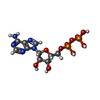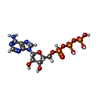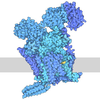[English] 日本語
 Yorodumi
Yorodumi- PDB-8usb: Non-substrate-engaged human 26S proteasome with Nub1/FAT10 bound ... -
+ Open data
Open data
- Basic information
Basic information
| Entry | Database: PDB / ID: 8usb | ||||||
|---|---|---|---|---|---|---|---|
| Title | Non-substrate-engaged human 26S proteasome with Nub1/FAT10 bound to Rpn1 | ||||||
 Components Components |
| ||||||
 Keywords Keywords | HYDROLASE/PROTEIN BINDING / 26S protease complex / Nub1 / FAT10 / MOTOR PROTEIN / HYDROLASE-PROTEIN BINDING complex | ||||||
| Function / homology |  Function and homology information Function and homology informationregulation of ubiquitin-dependent protein catabolic process / Lewy body / thyrotropin-releasing hormone receptor binding / nuclear proteasome complex / host-mediated perturbation of viral transcription / positive regulation of inclusion body assembly / Impaired BRCA2 translocation to the nucleus / Impaired BRCA2 binding to SEM1 (DSS1) / Hydrolases; Acting on peptide bonds (peptidases); Omega peptidases / proteasome accessory complex ...regulation of ubiquitin-dependent protein catabolic process / Lewy body / thyrotropin-releasing hormone receptor binding / nuclear proteasome complex / host-mediated perturbation of viral transcription / positive regulation of inclusion body assembly / Impaired BRCA2 translocation to the nucleus / Impaired BRCA2 binding to SEM1 (DSS1) / Hydrolases; Acting on peptide bonds (peptidases); Omega peptidases / proteasome accessory complex / integrator complex / purine ribonucleoside triphosphate binding / meiosis I / proteasome regulatory particle / cytosolic proteasome complex / positive regulation of proteasomal protein catabolic process / proteasome-activating activity / proteasome regulatory particle, lid subcomplex / proteasome regulatory particle, base subcomplex / metal-dependent deubiquitinase activity / protein K63-linked deubiquitination / negative regulation of programmed cell death / Regulation of ornithine decarboxylase (ODC) / Proteasome assembly / Cross-presentation of soluble exogenous antigens (endosomes) / proteasome core complex / Homologous DNA Pairing and Strand Exchange / Defective homologous recombination repair (HRR) due to BRCA1 loss of function / Defective HDR through Homologous Recombination Repair (HRR) due to PALB2 loss of BRCA1 binding function / Defective HDR through Homologous Recombination Repair (HRR) due to PALB2 loss of BRCA2/RAD51/RAD51C binding function / Resolution of D-loop Structures through Synthesis-Dependent Strand Annealing (SDSA) / Somitogenesis / Resolution of D-loop Structures through Holliday Junction Intermediates / K63-linked deubiquitinase activity / Impaired BRCA2 binding to RAD51 / proteasome binding / transcription factor binding / regulation of protein catabolic process / myofibril / response to tumor necrosis factor / proteasome storage granule / Presynaptic phase of homologous DNA pairing and strand exchange / general transcription initiation factor binding / blastocyst development / positive regulation of RNA polymerase II transcription preinitiation complex assembly / polyubiquitin modification-dependent protein binding / protein deubiquitination / immune system process / NF-kappaB binding / response to type II interferon / proteasome endopeptidase complex / endopeptidase activator activity / proteasome core complex, beta-subunit complex / mRNA export from nucleus / proteasome assembly / threonine-type endopeptidase activity / proteasome core complex, alpha-subunit complex / proteasomal protein catabolic process / SARS-CoV-1 targets host intracellular signalling and regulatory pathways / enzyme regulator activity / regulation of proteasomal protein catabolic process / ERAD pathway / inclusion body / proteasome complex / TBP-class protein binding / proteolysis involved in protein catabolic process / sarcomere / Regulation of activated PAK-2p34 by proteasome mediated degradation / Autodegradation of Cdh1 by Cdh1:APC/C / APC/C:Cdc20 mediated degradation of Securin / N-glycan trimming in the ER and Calnexin/Calreticulin cycle / Asymmetric localization of PCP proteins / Ubiquitin-dependent degradation of Cyclin D / SCF-beta-TrCP mediated degradation of Emi1 / NIK-->noncanonical NF-kB signaling / TNFR2 non-canonical NF-kB pathway / AUF1 (hnRNP D0) binds and destabilizes mRNA / stem cell differentiation / Vpu mediated degradation of CD4 / Assembly of the pre-replicative complex / Ubiquitin-Mediated Degradation of Phosphorylated Cdc25A / Degradation of DVL / Dectin-1 mediated noncanonical NF-kB signaling / Cdc20:Phospho-APC/C mediated degradation of Cyclin A / negative regulation of inflammatory response to antigenic stimulus / Degradation of AXIN / P-body / Hh mutants are degraded by ERAD / lipopolysaccharide binding / Activation of NF-kappaB in B cells / Degradation of GLI1 by the proteasome / G2/M Checkpoints / Hedgehog ligand biogenesis / GSK3B and BTRC:CUL1-mediated-degradation of NFE2L2 / Defective CFTR causes cystic fibrosis / Autodegradation of the E3 ubiquitin ligase COP1 / Negative regulation of NOTCH4 signaling / Regulation of RUNX3 expression and activity / Vif-mediated degradation of APOBEC3G / Hedgehog 'on' state Similarity search - Function | ||||||
| Biological species |  Homo sapiens (human) Homo sapiens (human) | ||||||
| Method | ELECTRON MICROSCOPY / single particle reconstruction / cryo EM / Resolution: 2.73 Å | ||||||
 Authors Authors | Arkinson, C. / Gee, C.L. / Martin, A. | ||||||
| Funding support |  United States, 1items United States, 1items
| ||||||
 Citation Citation |  Journal: Nat Struct Mol Biol / Year: 2025 Journal: Nat Struct Mol Biol / Year: 2025Title: NUB1 traps unfolded FAT10 for ubiquitin-independent degradation by the 26S proteasome. Authors: Connor Arkinson / Ken C Dong / Christine L Gee / Shawn M Costello / Aimee Chi Soe / Greg L Hura / Susan Marqusee / Andreas Martin /  Abstract: The ubiquitin-like modifier FAT10 targets hundreds of proteins in the mammalian immune system to the 26S proteasome for degradation. This degradation pathway requires the cofactor NUB1, yet the ...The ubiquitin-like modifier FAT10 targets hundreds of proteins in the mammalian immune system to the 26S proteasome for degradation. This degradation pathway requires the cofactor NUB1, yet the underlying mechanisms remain unknown. Here, we reconstituted a minimal in vitro system with human components and revealed that NUB1 uses the intrinsic instability of FAT10 to trap its N-terminal ubiquitin-like domain in an unfolded state and deliver it to the 26S proteasome for engagement, allowing the degradation of FAT10-ylated substrates in a ubiquitin-independent and p97-independent manner. Using hydrogen-deuterium exchange, structural modeling and site-directed mutagenesis, we identified the formation of an intricate complex with FAT10 that activates NUB1 for docking to the 26S proteasome, and our cryo-EM studies visualized the highly dynamic NUB1 complex bound to the proteasomal Rpn1 subunit during FAT10 delivery and the early stages of ATP-dependent degradation. These findings identified a previously unknown mode of cofactor-mediated, ubiquitin-independent substrate delivery to the 26S proteasome that relies on trapping partially unfolded states for engagement by the proteasomal ATPase motor. | ||||||
| History |
|
- Structure visualization
Structure visualization
| Structure viewer | Molecule:  Molmil Molmil Jmol/JSmol Jmol/JSmol |
|---|
- Downloads & links
Downloads & links
- Download
Download
| PDBx/mmCIF format |  8usb.cif.gz 8usb.cif.gz | 2.1 MB | Display |  PDBx/mmCIF format PDBx/mmCIF format |
|---|---|---|---|---|
| PDB format |  pdb8usb.ent.gz pdb8usb.ent.gz | Display |  PDB format PDB format | |
| PDBx/mmJSON format |  8usb.json.gz 8usb.json.gz | Tree view |  PDBx/mmJSON format PDBx/mmJSON format | |
| Others |  Other downloads Other downloads |
-Validation report
| Summary document |  8usb_validation.pdf.gz 8usb_validation.pdf.gz | 2.3 MB | Display |  wwPDB validaton report wwPDB validaton report |
|---|---|---|---|---|
| Full document |  8usb_full_validation.pdf.gz 8usb_full_validation.pdf.gz | 2.4 MB | Display | |
| Data in XML |  8usb_validation.xml.gz 8usb_validation.xml.gz | 218.3 KB | Display | |
| Data in CIF |  8usb_validation.cif.gz 8usb_validation.cif.gz | 344.4 KB | Display | |
| Arichive directory |  https://data.pdbj.org/pub/pdb/validation_reports/us/8usb https://data.pdbj.org/pub/pdb/validation_reports/us/8usb ftp://data.pdbj.org/pub/pdb/validation_reports/us/8usb ftp://data.pdbj.org/pub/pdb/validation_reports/us/8usb | HTTPS FTP |
-Related structure data
| Related structure data |  42506MC  8uscC  8usdC M: map data used to model this data C: citing same article ( |
|---|---|
| Similar structure data | Similarity search - Function & homology  F&H Search F&H Search |
- Links
Links
- Assembly
Assembly
| Deposited unit | 
|
|---|---|
| 1 |
|
- Components
Components
-26S proteasome non-ATPase regulatory subunit ... , 11 types, 11 molecules WbdfUVcYZaX
| #1: Protein | Mass: 52979.359 Da / Num. of mol.: 1 / Source method: isolated from a natural source / Source: (natural)  Homo sapiens (human) / References: UniProt: O00232 Homo sapiens (human) / References: UniProt: O00232 |
|---|---|
| #3: Protein | Mass: 40781.590 Da / Num. of mol.: 1 / Source method: isolated from a natural source / Source: (natural)  Homo sapiens (human) / References: UniProt: P55036 Homo sapiens (human) / References: UniProt: P55036 |
| #4: Protein | Mass: 39667.871 Da / Num. of mol.: 1 / Source method: isolated from a natural source / Source: (natural)  Homo sapiens (human) / Cell line: HEK293 / References: UniProt: P48556 Homo sapiens (human) / Cell line: HEK293 / References: UniProt: P48556 |
| #5: Protein | Mass: 100313.625 Da / Num. of mol.: 1 / Source method: isolated from a natural source / Source: (natural)  Homo sapiens (human) / Cell line: HEK293 / References: UniProt: Q13200 Homo sapiens (human) / Cell line: HEK293 / References: UniProt: Q13200 |
| #20: Protein | Mass: 105958.234 Da / Num. of mol.: 1 / Source method: isolated from a natural source / Source: (natural)  Homo sapiens (human) / Cell line: HEK293 / References: UniProt: Q99460 Homo sapiens (human) / Cell line: HEK293 / References: UniProt: Q99460 |
| #21: Protein | Mass: 61066.500 Da / Num. of mol.: 1 / Source method: isolated from a natural source / Source: (natural)  Homo sapiens (human) / Cell line: HEK293 / References: UniProt: O43242 Homo sapiens (human) / Cell line: HEK293 / References: UniProt: O43242 |
| #22: Protein | Mass: 46940.898 Da / Num. of mol.: 1 Source method: isolated from a genetically manipulated source Details: The human cell line has been modified with a retrovirus to incorporate the non-ATPase regulatory subunit 14 with i an affinity tag comprising HTBH (6-His, TEV, biotin, 6-His) at the C- ...Details: The human cell line has been modified with a retrovirus to incorporate the non-ATPase regulatory subunit 14 with i an affinity tag comprising HTBH (6-His, TEV, biotin, 6-His) at the C-terminus https://doi.org/10.1021/bi061994u Source: (gene. exp.)  Homo sapiens (human) / Cell line: HEK293 / Gene: PSMD14 / Production host: Homo sapiens (human) / Cell line: HEK293 / Gene: PSMD14 / Production host:  Homo sapiens (human) / References: UniProt: O00487 Homo sapiens (human) / References: UniProt: O00487 |
| #24: Protein | Mass: 45592.285 Da / Num. of mol.: 1 / Source method: isolated from a natural source / Source: (natural)  Homo sapiens (human) / Cell line: HEK293 / References: UniProt: Q15008 Homo sapiens (human) / Cell line: HEK293 / References: UniProt: Q15008 |
| #25: Protein | Mass: 37086.441 Da / Num. of mol.: 1 / Source method: isolated from a natural source / Source: (natural)  Homo sapiens (human) / Cell line: HEK293 / References: UniProt: P51665 Homo sapiens (human) / Cell line: HEK293 / References: UniProt: P51665 |
| #26: Protein | Mass: 42995.359 Da / Num. of mol.: 1 / Source method: isolated from a natural source / Source: (natural)  Homo sapiens (human) / Cell line: HEK293 / References: UniProt: Q9UNM6 Homo sapiens (human) / Cell line: HEK293 / References: UniProt: Q9UNM6 |
| #27: Protein | Mass: 47526.688 Da / Num. of mol.: 1 / Source method: isolated from a natural source / Source: (natural)  Homo sapiens (human) / Cell line: HEK293 / References: UniProt: O00231 Homo sapiens (human) / Cell line: HEK293 / References: UniProt: O00231 |
-26S protease regulatory subunit ... , 2 types, 2 molecules CE
| #2: Protein | Mass: 45694.047 Da / Num. of mol.: 1 / Source method: isolated from a natural source / Source: (natural)  Homo sapiens (human) / References: UniProt: P62195 Homo sapiens (human) / References: UniProt: P62195 |
|---|---|
| #10: Protein | Mass: 44241.008 Da / Num. of mol.: 1 / Source method: isolated from a natural source / Source: (natural)  Homo sapiens (human) / References: UniProt: P62333 Homo sapiens (human) / References: UniProt: P62333 |
-Protein , 3 types, 3 molecules gOe
| #6: Protein | Mass: 69542.938 Da / Num. of mol.: 1 Source method: isolated from a genetically manipulated source Source: (gene. exp.)  Homo sapiens (human) / Gene: NUB1 / Production host: Homo sapiens (human) / Gene: NUB1 / Production host:  |
|---|---|
| #19: Protein | Mass: 30000.418 Da / Num. of mol.: 1 / Source method: isolated from a natural source / Source: (natural)  Homo sapiens (human) / Cell line: HEK293 Homo sapiens (human) / Cell line: HEK293References: UniProt: Q99436, proteasome endopeptidase complex |
| #23: Protein | Mass: 8284.611 Da / Num. of mol.: 1 / Source method: isolated from a natural source / Source: (natural)  Homo sapiens (human) / Cell line: HEK203 / References: UniProt: P60896 Homo sapiens (human) / Cell line: HEK203 / References: UniProt: P60896 |
-26S proteasome regulatory subunit ... , 4 types, 4 molecules BADF
| #7: Protein | Mass: 49260.504 Da / Num. of mol.: 1 / Source method: isolated from a natural source / Source: (natural)  Homo sapiens (human) / Cell line: HEK293 / References: UniProt: P62191 Homo sapiens (human) / Cell line: HEK293 / References: UniProt: P62191 |
|---|---|
| #8: Protein | Mass: 48700.805 Da / Num. of mol.: 1 / Source method: isolated from a natural source / Source: (natural)  Homo sapiens (human) / Cell line: HEK293 / References: UniProt: P35998 Homo sapiens (human) / Cell line: HEK293 / References: UniProt: P35998 |
| #9: Protein | Mass: 47426.141 Da / Num. of mol.: 1 / Source method: isolated from a natural source / Source: (natural)  Homo sapiens (human) / Cell line: HEK293 / References: UniProt: P43686 Homo sapiens (human) / Cell line: HEK293 / References: UniProt: P43686 |
| #11: Protein | Mass: 49266.457 Da / Num. of mol.: 1 / Source method: isolated from a natural source / Source: (natural)  Homo sapiens (human) / Cell line: HEK293 / References: UniProt: P17980 Homo sapiens (human) / Cell line: HEK293 / References: UniProt: P17980 |
-Proteasome subunit alpha type- ... , 7 types, 7 molecules GHIJKLM
| #12: Protein | Mass: 27432.459 Da / Num. of mol.: 1 / Source method: isolated from a natural source / Source: (natural)  Homo sapiens (human) / Cell line: HEK293 Homo sapiens (human) / Cell line: HEK293References: UniProt: P60900, proteasome endopeptidase complex |
|---|---|
| #13: Protein | Mass: 25927.535 Da / Num. of mol.: 1 / Source method: isolated from a natural source / Source: (natural)  Homo sapiens (human) / Cell line: HEK293 Homo sapiens (human) / Cell line: HEK293References: UniProt: P25787, proteasome endopeptidase complex |
| #14: Protein | Mass: 29525.842 Da / Num. of mol.: 1 / Source method: isolated from a natural source / Source: (natural)  Homo sapiens (human) / Cell line: HEK293 Homo sapiens (human) / Cell line: HEK293References: UniProt: P25789, proteasome endopeptidase complex |
| #15: Protein | Mass: 27929.891 Da / Num. of mol.: 1 / Source method: isolated from a natural source / Source: (natural)  Homo sapiens (human) / Cell line: HEK293 Homo sapiens (human) / Cell line: HEK293References: UniProt: O14818, proteasome endopeptidase complex |
| #16: Protein | Mass: 26435.977 Da / Num. of mol.: 1 / Source method: isolated from a natural source / Source: (natural)  Homo sapiens (human) Homo sapiens (human)References: UniProt: P28066, proteasome endopeptidase complex |
| #17: Protein | Mass: 29595.627 Da / Num. of mol.: 1 / Source method: isolated from a natural source / Source: (natural)  Homo sapiens (human) / Cell line: HEK293 Homo sapiens (human) / Cell line: HEK293References: UniProt: P25786, proteasome endopeptidase complex |
| #18: Protein | Mass: 28469.252 Da / Num. of mol.: 1 / Source method: isolated from a natural source / Source: (natural)  Homo sapiens (human) / Cell line: HEK293 Homo sapiens (human) / Cell line: HEK293References: UniProt: P25788, proteasome endopeptidase complex |
-Non-polymers , 4 types, 13 molecules 






| #28: Chemical | ChemComp-ADP / | ||||
|---|---|---|---|---|---|
| #29: Chemical | ChemComp-MG / #30: Chemical | ChemComp-ATP / #31: Chemical | ChemComp-ZN / | |
-Details
| Has ligand of interest | Y |
|---|---|
| Has protein modification | Y |
| Sequence details | The human cell line has been modified with a retrovirus to incorporate the non-ATPase regulatory ...The human cell line has been modified with a retrovirus to incorporate the non-ATPase regulatory subunit 14 with i an affinity tag comprising HTBH (6-His, TEV, biotin, 6-His) at the C-terminus https://doi.org/10.1021/bi061994u |
-Experimental details
-Experiment
| Experiment | Method: ELECTRON MICROSCOPY |
|---|---|
| EM experiment | Aggregation state: PARTICLE / 3D reconstruction method: single particle reconstruction |
- Sample preparation
Sample preparation
| Component |
| |||||||||||||||||||||
|---|---|---|---|---|---|---|---|---|---|---|---|---|---|---|---|---|---|---|---|---|---|---|
| Molecular weight |
| |||||||||||||||||||||
| Source (natural) |
| |||||||||||||||||||||
| Source (recombinant) |
| |||||||||||||||||||||
| Buffer solution | pH: 7.4 Details: 30 mM HEPES pH7.4, 25 mM NaCl, 25 mM KCl, 3% (v/v) glycerol, 5 mM MgCl2 2 mM ATP and 0.5 mM TCEP | |||||||||||||||||||||
| Specimen | Embedding applied: NO / Shadowing applied: NO / Staining applied: NO / Vitrification applied: YES | |||||||||||||||||||||
| Specimen support | Details: 25 mA / Grid material: GOLD / Grid mesh size: 500 divisions/in. / Grid type: UltrAuFoil R2/2 | |||||||||||||||||||||
| Vitrification | Instrument: FEI VITROBOT MARK IV / Cryogen name: ETHANE / Humidity: 100 % / Chamber temperature: 298 K |
- Electron microscopy imaging
Electron microscopy imaging
| Experimental equipment |  Model: Titan Krios / Image courtesy: FEI Company |
|---|---|
| Microscopy | Model: TFS KRIOS |
| Electron gun | Electron source:  FIELD EMISSION GUN / Accelerating voltage: 300 kV / Illumination mode: FLOOD BEAM FIELD EMISSION GUN / Accelerating voltage: 300 kV / Illumination mode: FLOOD BEAM |
| Electron lens | Mode: BRIGHT FIELD / Nominal defocus max: 1700 nm / Nominal defocus min: 500 nm / Alignment procedure: BASIC |
| Specimen holder | Cryogen: NITROGEN / Specimen holder model: FEI TITAN KRIOS AUTOGRID HOLDER |
| Image recording | Electron dose: 50 e/Å2 / Film or detector model: GATAN K3 (6k x 4k) |
- Processing
Processing
| EM software | Name: PHENIX / Version: 1.21_5207 / Category: model refinement | ||||||||||||||||||||||||
|---|---|---|---|---|---|---|---|---|---|---|---|---|---|---|---|---|---|---|---|---|---|---|---|---|---|
| CTF correction | Type: PHASE FLIPPING AND AMPLITUDE CORRECTION | ||||||||||||||||||||||||
| 3D reconstruction | Resolution: 2.73 Å / Resolution method: FSC 0.143 CUT-OFF / Num. of particles: 50918 / Symmetry type: POINT | ||||||||||||||||||||||||
| Refinement | Cross valid method: NONE Stereochemistry target values: GeoStd + Monomer Library + CDL v1.2 | ||||||||||||||||||||||||
| Displacement parameters | Biso mean: 126.98 Å2 | ||||||||||||||||||||||||
| Refine LS restraints |
|
 Movie
Movie Controller
Controller




 PDBj
PDBj
















